Have you ever dreamed of taking a New Zealand travel adventure amongst the beautiful, lush, green landscapes? Maybe you are an avid fan of The Lord of the Rings and The Hobbit and want to see where the movies were filmed. Maybe you have ancestors from these islands in the Pacific and want to learn more about the culture and heritage there. Whatever the reason, New Zealand is a remarkable destination for beauty and inspiration.
Traveling New Zealand
New Zealand is an island nation in the Pacific Ocean. It is made of 2 main islands and nearly 600 smaller ones. This country is approximately 1,500 km (932 miles) southeast of Australia. Because New Zealand is in the southern hemisphere, its summer months are December, January, and February, and its winter months are June, July, and August.
The busiest tourist times for New Zealand travel are December through February. Tourists can arrive by plane or boat. Once you have arrived in New Zealand, you will want to travel around to see all the amazing historical and popular destinations. You can rent a car, rent a motorhome, take a bus, or even ride a bike! When you are ready to visit another island, you can hop on a ferry or water taxi.
You might not consider hiking a mode of travel, but it is in New Zealand. The Fiordland National Park, located on New Zealand’s South Island, is known as the walking capital of the world. Hikers are known as “trampers” on the islands. One of the most popular trails is the Milford Track. It is 33 miles (53 km) and called the “Finest Walk in the World."
Walking wasn’t always just a fun pastime, however. Your New Zealand ancestors likely walked or rode horses until the early part of the 20th century. The first motor car was imported into the islands in 1898.
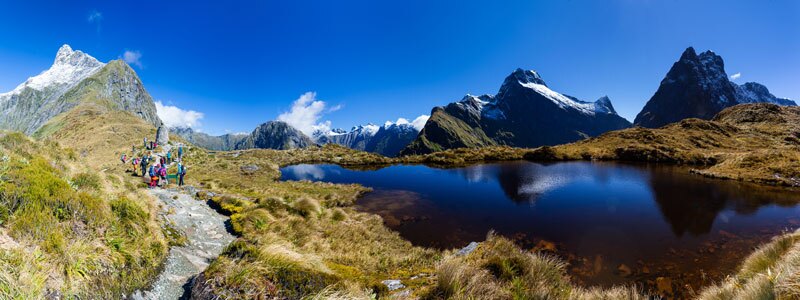
Popular Attractions
Bays and Beaches
For those of you who enjoy the sun and water, Poor Knights Islands and Bay of Islands are 2 of the best places for your New Zealand travel list! Poor Knights Islands include one of the best diving sites in the world. Here you can see a myriad of diverse fish and underwater plant life. If diving isn’t your thing, you can snorkel or take a paddle boat over the beautiful water.
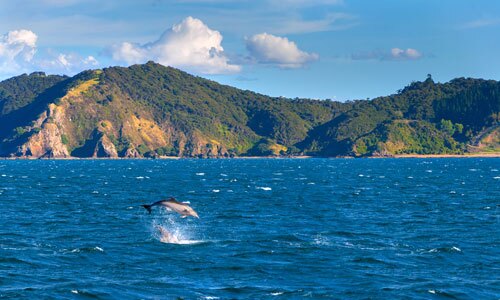
The Bay of Islands offers beautiful beaches and gorgeous views. This subtropical area encompasses 144 small islands. Visitors enjoy the long stretches of white sand and maritime delights with penguins, marlin, whales, and dolphins!
Did your ancestors walk on these same beaches? Perhaps they didn’t visit for pleasure, but for medicinal purposes. It was believed that good sea air and a shock of cold sea water would give health and strength to the ailing person.
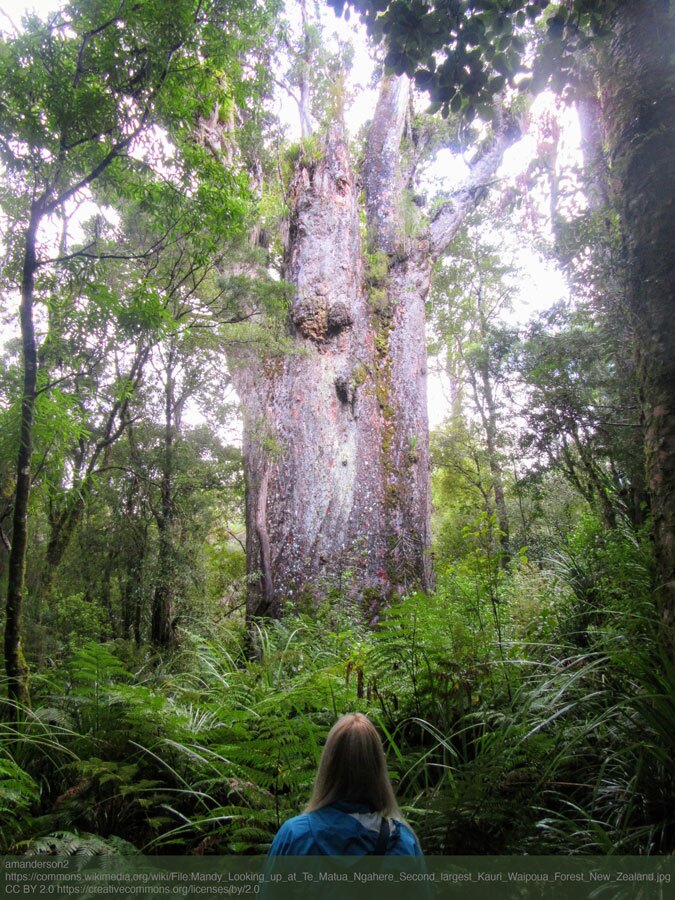
Waipoua Forest
The magical Waipoua Forest is a must-see attraction on the North Island. It is home to the beloved kauri trees. The kauri trees of the Waipoua Forest are sacred to the Māori people of New Zealand. They believe the ancestor of the kauri tree created life. This treasured tree also represents the overall health and well-being of the forest and the people. To learn more about the Māori culture, legends, and song, you can take a tour with Footprints Waipoua.
The Waipoua Forest is home to Tane Mahuta and Te Matua Ngahere. Tane Mahuta is the largest kauri tree in the country. It is sometimes called “The Lord of the Forest” and measures almost 59 feet (18 meters) tall. Te Matua Ngahere, another famous tree in the Waipoua Forest, is known as the “Father of the Forest.” Te Matua Ngahere is estimated to be more than 2,000 years old.
Hobbiton Movie Set
One of the most popular attractions in New Zealand today is HobbitonTM. Elves, dwarfs, and men can step into the Shire and the world of hobbits. After filming The Hobbit trilogy, 44 constructed Hobbit Holes™ were left in complete detail as seen in the film. Guests can peruse The Green Dragon Inn, the Mill, and enjoy drinks at the HobbitonTM SouthfarthingTM Range.
Hundertwasser Toilets
Imagine your city being known for the amazing public toilets it has. The Hundertwasser Toilets can be found at 60 Gillies Street in Kawakawa. Designed and created by Friedensreich Hundertwasser, these public facilities are considered an international work of art. The corky and unique structure was made with recycled materials like old bottles and bricks from the area. The toilet building has a live tree in the center and an organic green roof. The majority of people visit the toilets just to get a picture, but the facilities are open for “use.”
Historical Attractions
Kerikeri Mission Station
Kerikeri Mission Station is home to some of New Zealand’s oldest buildings. The mission station was one of the first places the Māori invited Europeans to settle alongside them. If you had ancestors who lived here, be sure to add this location to your New Zealand travel itinerary.
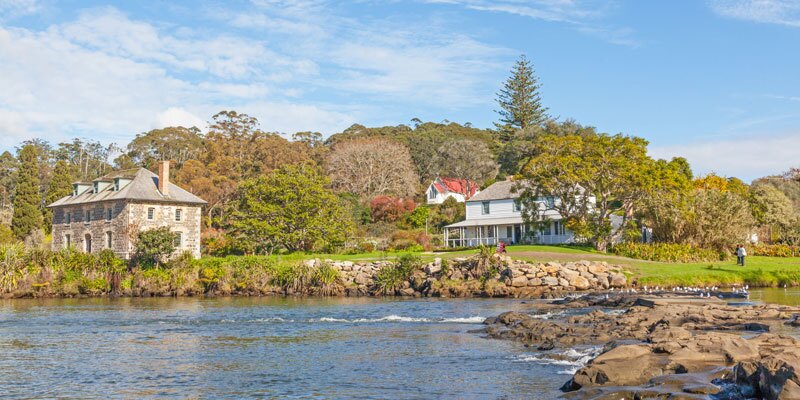
Three important buildings can be found there: Kemp House, the Stone Store, and St. James Church. Kemp House (established 1821–1822) is the oldest European building in New Zealand and still survives today. Visitors have to take a guided tour to enjoy the old house, though.
The Stone Store (established 1832–1836) was originally a Missionary Society storage depot, but it was converted to a general store in the 1870s. It is a fun place for the whole family to delight in.
Lastly, the quaint St. James Anglican Church (established 1878) with its stained-glass windows, high peaks, and little cemetery is the perfect place for family historians. Many members of the Kemp family are buried in the cemetery at St. James Church.
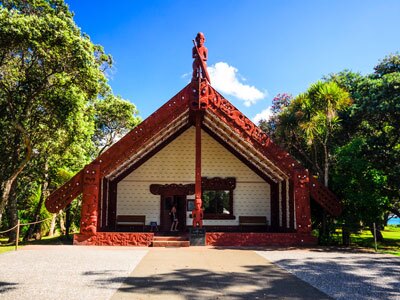
Waitangi Treaty Grounds
The Waitangi Treaty Grounds are another noteworthy historical site of New Zealand. It was here that about 40 Māori chiefs signed a treaty with the British Crown on February 6, 1840.
Today, the Waitangi Treaty Grounds are home to a museum filled with many taonga (treasures). Visitors can see facsimiles of the treaty documents, see and touch a giant Māori war canoe, and enjoy the gift shop and carving studio.
Did your New Zealand ancestor sign the Waitangi Treaty? Check out this list of the signers by name and location!
Manea
Kia ora! This is the Māori traditional phrase of welcome. It can mean “have life," "be healthy," or "good health," and it wishes the essence of life on those you meet.
Māori are the indigenous Polynesian people of New Zealand who arrived to the islands sometime between 1200 and 1300 AD. They arrived from their Polynesian homeland of Hawaiki. Visitors can embrace Māori tradition and learn their history by visiting Manea. Here, you can take a tour and walk the footprints of Kupe, the Polynesian explorer who first discovered New Zealand. Situated on the shores of Hokianga Harbor, visitors will learn more about Māori culture and traditions through art, performance, and film.
Dunedin City and the Scots
The first Scottish people arrived in New Zealand on the Endeavour, one of Captain Cook’s ships, in 1769. A larger influx of Scottish immigrants arrived between 1840 and 1900. A settlement at Dunedin (Gaelic for Edinburgh) was established in 1848 on behalf of the Presbyterian Free Church of Scotland.
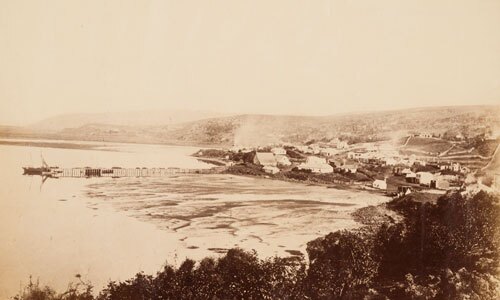
John McGlashan, Reverend Thomas Burns, and Captain William Cargill were among the leaders of the Endeavour. Over the next 200 years, many Scottish people seeking to escape poverty were drawn to New Zealand.
In 1988, the Otago Scottish Heritage Council officially adopted the Dunedin Tartan designed by Vilma Nelson. The tartan exhibits small white stripes representing the first 2 ships, blue stripes to represent the sea they crossed, green background for new pastures, gold for the crops they grew, red for the blood ties left behind in their homeland, and black for the sadness of loved ones missed.
The Scottish influence is still seen in New Zealand today with events and celebrations enjoyed year-round. Pipe bands, highland games, and the one and only Dunedin Haggis Ceremony are just a few of the ways New Zealanders celebrate their Scottish heritage.
Record Archives for Genealogy and Family History
Researching your New Zealand ancestry can be done in several locations while on the islands. There are national archives, local archives, libraries, and FamilySearch centers. Each have their own unique holdings that will help you trace your immigrant or Māori roots.
Archives New Zealand
The Archives New Zealand are located in 4 places: Auckland, Wellington, Christchurch, and Dunedin. Collectively, these establishments hold over 6 million records beginning in about 1840. Holdings include, but are not limited to, the following types of records:
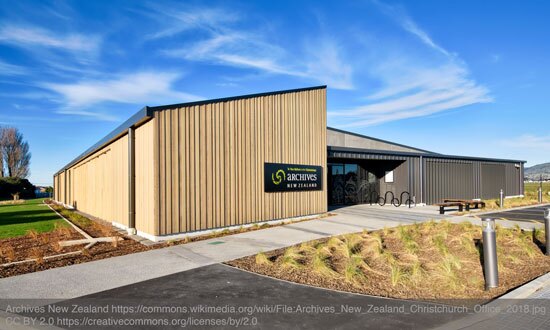
- Immigration and citizenship files
- Court records, including divorce records, bankruptcy files, and probated wills
- Records from Māori Land Courts and Boards, minute books, alienation, and confiscation files
- Coroners’ inquests into deaths
- Land registrations, crown land administration, and early survey plans
- School archives
- Health and welfare records
- Police and prisons records
- Mining records
Each of the 4 repositories also hold special collections unique to that location. Archives New Zealand does not hold records such as births, marriages, deaths, shipping manifests, censuses, and newspapers.
Other Repositories
For those vital records needed for filling out your family tree, the FamilySearch New Zealand collections or the New Zealand Government website can lead you in the right direction. You can order birth, marriage, death, and even military records from the website.
See the Comprehensive List of Online Genealogy Records for New Zealand
National Libraries and FamilySearch Centers

FamilySearch centers have more access than affiliate libraries do. Typically, FamilySearch centers are found in a ward or stake building of The Church of Jesus Christ of Latter-day Saints. You can see a map of FamilySearch centers and affiliates in New Zealand on FamilySearch.
There are 3 National Libraries in New Zealand located at Wellington, Auckland, and Christchurch. Here, you may find newspaper articles about your ancestors, their old diaries, or other published material. The National Libraries website offers a comprehensive guide to researching your New Zealand ancestry.
The National Libraries are each official FamilySearch affiliate libraries. This means that records that are not available for your viewing at home can be viewed here. There are also helpful people available to assist you with any questions you might have.
Record Your New Zealand Travel Stories
Whether you've had the chance to travel to New Zealand yourself or you're trying to preserve the stories of your ancestors' experiences in New Zealand, you can use FamilySearch Memories to help you keep track of all these stories. You can include photos, audio recordings, and even upload documents to help these memories come alive for whoever reads them.
Learn More about New Zealand Heritage
At FamilySearch, we care about connecting you with your family, and we provide fun discovery experiences and family history services for free. Why? Because we cherish families and believe that connecting generations can improve our lives now and forever. We are a nonprofit organization sponsored by The Church of Jesus Christ of Latter-day Saints. To learn more about our beliefs, click here.





